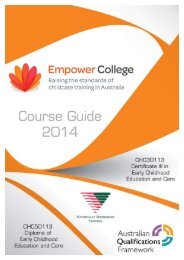Peer coaching booklet
You also want an ePaper? Increase the reach of your titles
YUMPU automatically turns print PDFs into web optimized ePapers that Google loves.
Coaching as a<br />
professional<br />
development tool<br />
Showers and Joyce (1996) initially<br />
researched peer <strong>coaching</strong> in 1982<br />
and compared peer <strong>coaching</strong> to<br />
traditional in-service training. The<br />
study found that teachers who<br />
attended in-service training alone had<br />
a low rate of transfer and were not<br />
able to find ways to generally improve<br />
their practice from the in-service<br />
training alone. When peer <strong>coaching</strong><br />
was added the implementation of new<br />
teaching methodologies rose<br />
dramatically.<br />
Subheader<br />
Dolore repreicietur acillandus asitium aut fugia<br />
nimoluptate etur? Quibus con conem vendam<br />
eatet aborum nis quidebi ssitas et volupta ditior<br />
rem et harci optasincim quo te sequasim quam<br />
volupta ssequiamet asperionesto tem vendestint.<br />
Ut aci te officit veni rehendit, que doluptam<br />
que id magnat. Is autasit emporiatur sume<br />
landaerupta vid eosam doluptatius porerchic tem<br />
fugiae dolessediti vit, qui dolupti odiscil escipit<br />
ibusapelique pre, quodita tionsedite.Inu- stem re<br />
voluptat. Tium harum iuribus daerum expliquo<br />
verum solupta simus quae corepta tempore<br />
rspitinum et ulparci sitio. Et abo. Ma- iorpo<br />
rporatem hitio molu.<br />
Dolore repreicietur acillandus asitium aut fugia<br />
nimoluptate etur? Quibus con conem vendam<br />
eatet aborum nis quidebi ssitas et volupta ditior<br />
rem et harci optasincim quo te sequasim quam<br />
volupta ssequiamet asperionesto tem vendestint.<br />
Ut aci te officit veni rehendit, que doluptam<br />
que id magnat. Is autasit emporiatur sume<br />
landaerupta vid eosam doluptatius porerchic tem<br />
fugiae dolessediti vit, qui dolupti odiscil escipit<br />
ibusapelique pre, quodita tionsedite.Inu- stem re<br />
voluptat. Tium harum iuribus daerum expliquo<br />
verum solupta simus quae corepta tempore<br />
rspitinum et ulparci sitio. Et abo. Ma- iorpo<br />
rporatem hitio molu.<br />
Kohler (1997) built on the work of<br />
Showers and Joyce and found that<br />
peer <strong>coaching</strong> allows reflection of<br />
current practice and develops<br />
leadership and collaboration. Whilst<br />
Kohler used different procedures for<br />
initiating and measuring the success<br />
of peer <strong>coaching</strong>, his research<br />
concurred with that of Shower and<br />
Joyce (1996) that peer <strong>coaching</strong> has<br />
the ultimate goal of developing,<br />
refining and sustaining teaching<br />
methodologies in order to meet<br />
students diverse learning capabilities.<br />
Dolore repreicietur acillandus asitium aut fugia<br />
nimoluptate etur? Quibus con conem vendam<br />
eatet aborum nis quidebi ssitas et volupta ditior<br />
rem et harci optasincim quo te sequasim quam<br />
volupta ssequiamet asperionesto tem vendestint.<br />
Ut aci te officit veni rehendit, que doluptam<br />
que id magnat. Is autasit emporiatur sume<br />
landaerupta vid eosam doluptatius porerchic tem<br />
fugiae dolessediti vit, qui dolupti odiscil escipit<br />
ibusapelique pre.<br />
Chapman (2008) examines the history and<br />
cultural context of professional development<br />
training for teachers and finds that whilst both<br />
past and present professional development<br />
training focus on enhancing skills, the<br />
ideology is different. Today’s processional<br />
development focuses on the unique<br />
differences of the individual rather than the<br />
similarities of the group which is why peer<br />
<strong>coaching</strong> is seen as a favourable option.<br />
Waddell (2005) and Chapman (2008) agree<br />
that peer <strong>coaching</strong> is highly effective at<br />
transferring newly acquired knowledge and<br />
skills into teaching methodologies and<br />
strategies. Waddell (2005) states that peer<br />
<strong>coaching</strong> is used to close the gap between<br />
what a “book knowledge” and “practical<br />
knowledge”, also building upon the work of<br />
Showers and Joyce (1982).<br />
Waddell builds on this concept and adds the<br />
question of the effectiveness of <strong>coaching</strong><br />
being hinged to the effectiveness of the<br />
particular coach and highlights the need for<br />
training for those in <strong>coaching</strong> roles.<br />
Trautwein and Ammerman (2010) concur with<br />
Waddell and suggest that peer <strong>coaching</strong> has<br />
the ability to allow mastery to occur,<br />
especially in new or pre-service teachers.<br />
Further demonstrating this is the statistic of<br />
80% of pre-service teachers in peer <strong>coaching</strong><br />
models meeting their two stated <strong>coaching</strong><br />
objectives.<br />
<strong>Peer</strong> <strong>coaching</strong> foundations<br />
7





